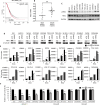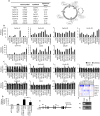Y-box binding protein 1/cyclin A1 axis specifically promotes cell cycle progression at G2/M phase in ovarian cancer
- PMID: 39289424
- PMCID: PMC11408696
- DOI: 10.1038/s41598-024-72174-9
Y-box binding protein 1/cyclin A1 axis specifically promotes cell cycle progression at G2/M phase in ovarian cancer
Abstract
Y-box binding protein 1 (YBX1) promotes oncogenic transformation and tumor growth. YBX1 plays a role in regulation of cell cycle promotion via upregulation of cell cycle-related genes. In ovarian cancer, YBX1 also promotes tumor growth, but the mechanisms of YBX1 in cell growth and cell cycle in ovarian cancer remain not to be fully understood. Here, we investigated whether YBX1-dependent cancer cell proliferation was specifically associated with expression of cell cycle related genes in ovarian cancer. Protein and mRNA expression levels of YBX1 and cell cycle-related genes in ovarian cancer cell lines and tissues were determined by western blot analysis, immunohistochemical analysis and reverse transcription-quantitative PCR. Cell cycle analysis was performed by flow cytometry. Luciferase assay and Chromatin immunoprecipitation assay were used to investigate a transcriptional function of YBX1. YBX1 silencing induced marked growth suppression in 4 cell lines (group A), moderate suppression in 5 cell lines (group B), and no suppression in 3 cell lines (group C) among 12 ovarian cancer cell lines in culture. The YBX1 silencing induced cell cycle arrest at G2/M phase and suppressed expression of cyclin A1 gene in group A and B cell lines, but not in group C cell lines. Cyclin A1 silencing specifically suppressed cell proliferation in group A cell lines and partially in group B cell lines, but not at all in group C cell lines. YBX1 mRNA levels were significantly correlated with cyclin A1 mRNA levels in patients with high-grade serous carcinoma. Augmented YBX1 expression plays a key role in tumor growth promotion in ovarian cancer in its close association with cyclin A1.
Keywords: Cell cycle; Cyclin A1; G2/M arrest; Ovarian cancer; YBX1.
© 2024. The Author(s).
Conflict of interest statement
The authors declare no competing interests.
Figures





References
-
- Batra, A. & Winquist, E. Emerging cell cycle inhibitors for treating metastatic castration-resistant prostate cancer. Expert Opin. Emerg. Drugs23, 271–282 (2018). - PubMed
-
- Kohno, K., Izumi, H., Uchiumi, T., Ashizuka, M. & Kuwano, M. The pleiotropic functions of the Y-box-binding protein, YB-1. BioEssays25, 691–698 (2003). - PubMed
MeSH terms
Substances
Grants and funding
LinkOut - more resources
Full Text Sources
Medical
Research Materials

